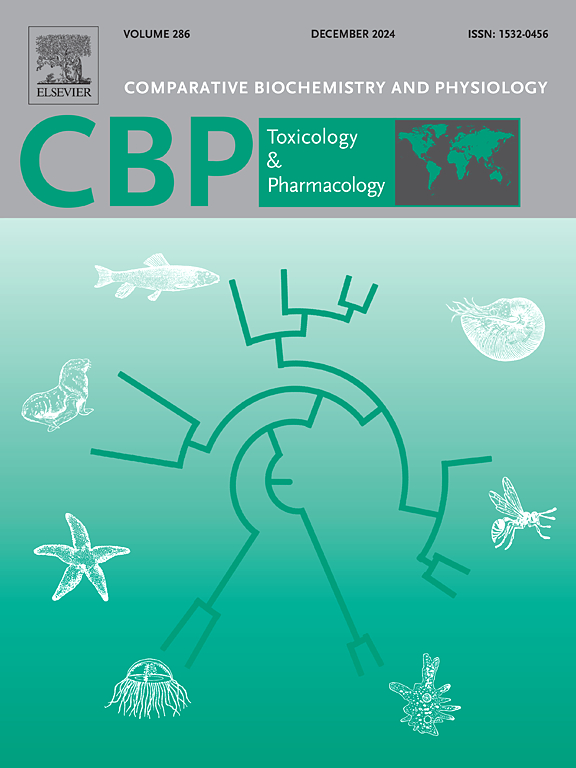Investigating insecticide resistance in eggplant fruit and shoot borer: Multi-class insecticides and detoxification gene expression
IF 3.9
3区 环境科学与生态学
Q2 BIOCHEMISTRY & MOLECULAR BIOLOGY
Comparative Biochemistry and Physiology C-toxicology & Pharmacology
Pub Date : 2025-04-24
DOI:10.1016/j.cbpc.2025.110210
引用次数: 0
Abstract
Eggplant fruit and shoot borer, Leucinodes orbonalis (Lepidoptera: Crambidae), is a destructive borer pest that infests eggplant crop from nursery stage to fruiting. This study aimed to evaluate the current insecticide resistance status of L. orbonalis collected from ten different locations of Tamil Nadu, India, using a fruit dip bioassay. Late second instar larvae were exposed to spinosad, spinetoram, thiacloprid and emamectin benzoate. Median lethal concentration (LC50) and resistance ratios (RR) were estimated for each population using a susceptible NBAIR population as a reference. The results showed that emamectin benzoate was highly toxic to L. orbonalis. All field populations exhibited a low to high level of resistance against spinosad (7.4 to 72.1 fold) and spinetoram (6.6 to 67.8 fold), while susceptibility to low levels of resistance was observed against thiacloprid (0.89 to 5.06 fold) and emamectin benzoate (1.48 to 11.29 fold). Additionally, detoxification enzyme assays were conducted for cytochrome P450 monooxygenases (CYP/MFO), glutathione S-transferases (GST) and carboxylesterases (CarE) revealing high specific activity in the Dharmapuri (DMP) population, correlating with resistance. Furthermore, quantitative real-time PCR analysis was conducted to assess detoxification gene expression in resistant (DMP) and susceptible populations after insecticide exposure, revealing significant overexpression of cyp306a1 and ce125 across the studied insecticides, particularly after 48 h, indicating their key role in resistance. These findings highlight the need for insecticide rotation with different modes of action to mitigate resistance development in L. orbonalis, providing valuable insights for sustainable pest management in Tamil Nadu and similar agricultural contexts worldwide.

茄子果实和螟虫对杀虫剂抗性的研究:多类杀虫剂和解毒基因表达
茄子果笋螟虫(Leucinodes orbonalis,鳞翅目:蛾科)是一种破坏性的螟虫,从苗期到结果期一直困扰着茄子作物。本研究采用果实浸渍生物测定法对印度泰米尔纳德邦10个不同地点采集的L. orbonalis的抗药性现状进行了评价。将二龄后期幼虫分别暴露于spinosad、spinetoram、噻虫啉和苯甲酸埃维菌素。以NBAIR易感人群为参考,估计每个人群的中位致死浓度(LC50)和抗性比(RR)。结果表明,苯甲酸埃维菌素对炭疽乳杆菌有剧毒作用。所有田间种群对spinosad(7.4 ~ 72.1倍)和spinetoram(6.6 ~ 67.8倍)表现出低至高的抗性,而对噻虫啉(0.89 ~ 5.06倍)和苯甲酸埃马菌素(1.48 ~ 11.29倍)表现出低水平的抗性。此外,对细胞色素P450单加氧酶(CYP/MFO)、谷胱甘肽s -转移酶(GST)和羧酸酯酶(CarE)进行了解毒酶测定,发现DMP群体具有较高的特异性活性,与抗性相关。此外,通过实时荧光定量PCR分析,对杀虫剂暴露后抗性(DMP)和易感群体的解毒基因表达进行了评估,发现cyp306a1和ce125在所研究的杀虫剂中显著过表达,特别是在48 h后,这表明它们在抗性中起关键作用。这些发现强调需要采用不同的作用模式来轮作杀虫剂,以减轻L. orbonalis的抗性发展,为泰米尔纳德邦和世界各地类似的农业环境的可持续害虫管理提供有价值的见解。
本文章由计算机程序翻译,如有差异,请以英文原文为准。
求助全文
约1分钟内获得全文
求助全文
来源期刊
CiteScore
7.50
自引率
5.10%
发文量
206
审稿时长
30 days
期刊介绍:
Part C: Toxicology and Pharmacology. This journal is concerned with chemical and drug action at different levels of organization, biotransformation of xenobiotics, mechanisms of toxicity, including reactive oxygen species and carcinogenesis, endocrine disruptors, natural products chemistry, and signal transduction with a molecular approach to these fields.

 求助内容:
求助内容: 应助结果提醒方式:
应助结果提醒方式:


